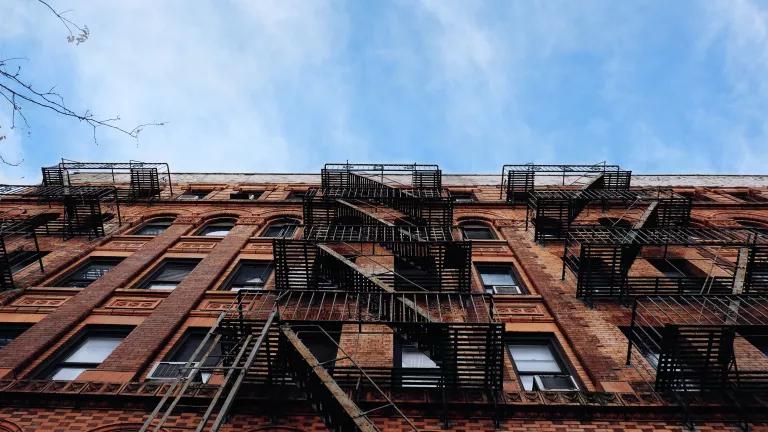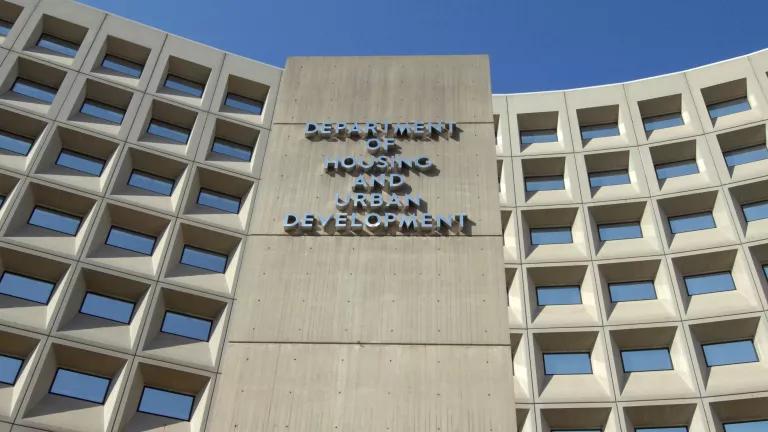Safe Indoor Temperatures Should Be a Right, Not a Luxury
The groundbreaking Inflation Reduction Act will support greater access to life-saving and climate-friendly cooling in people’s homes.
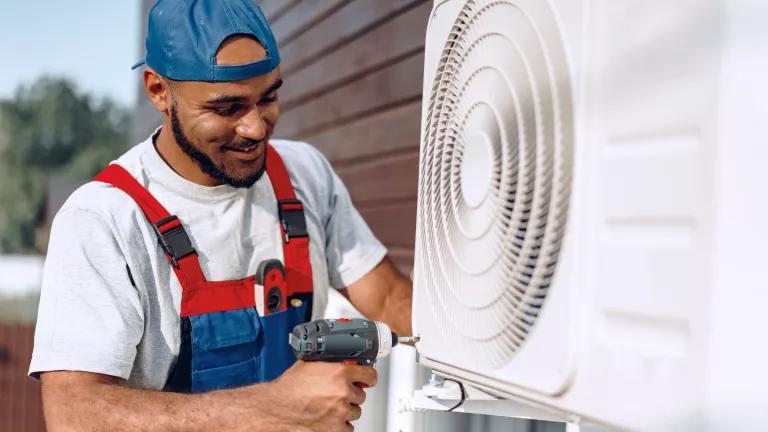
A worker installing an air conditioning unit outside a home.
The groundbreaking Inflation Reduction Act, which President Biden just signed into law, contains several provisions that will support clean, affordable residential cooling. This bill comes at a critical moment, as local and state governments try to protect vulnerable residents from unprecedented heat waves while also working to cut climate-warming pollution.
The Pros and Cons of Air Conditioning
The summer of 2022 has felt like one long heat wave. The average rate of heat-related illnesses in emergency departments was higher in May and June than over the same period in the last three years. July was the third hottest on record, with nearly a third of U.S. residents under heat advisories late in the month. Workers, unsheltered people, low-income renters, and communities of color have been among the hardest hit by the deadly heat. And we’re not done yet: much of the United States is expected to experience temperatures 1.8 to 3.6°F (1 to 2°C) hotter than average over the next three months.
Air conditioning is one of the easiest ways to maintain healthy indoor temperatures during extreme heat. (And when run in reverse, where they’re more frequently referred to as heat pumps, they’re also the cleanest way to maintain healthy indoor temperatures in the cold!) However, despite the wide prevalence of air conditioning units in U.S. homes—especially compared to Europe and the Global South—there are stark racial, socioeconomic, and regional differences in who has cooling equipment and who can afford to use it.
Lower-income households, people of color, and renters are less likely to have air conditioning units in their homes than wealthier and whiter homeowners. They’re also more likely to forgo use of existing units because they can’t afford to pay their utility bills or to repair broken units. In 2020, for instance, nearly 11 percent of Black householders were unable to use their air conditioners, compared to just over 4 percent of white householders.
People of color and low-income communities in the United States typically live in hotter neighborhoods than wealthier and whiter communities because of factors such as historic disinvestment, dense urban development, and a relative lack of tree cover.
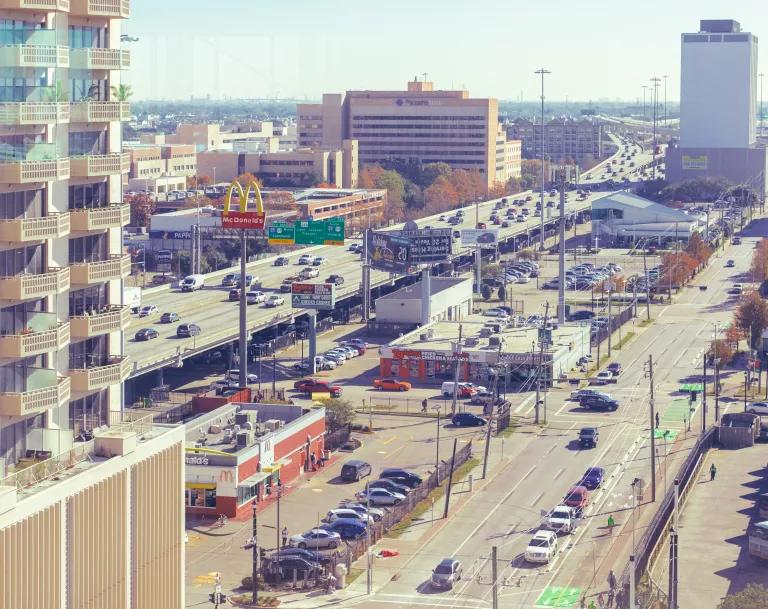
A lack of tree cover disproportionately exposes low-income communities and communities of color to extreme heat.
While air conditioning brings many benefits, there are also important costs. Beyond the price of the air conditioner itself, cooling air also consumes electricity. Units that run on electricity generated by fossil fuels dirty our air and warm our climate. Without the right kind of planning, increased demand for air conditioning also has the potential to increase utility bills and threaten the reliability of the electric grid.
Does that mean we should give up on air conditioning or limit how many more people get it in the future? As Rose Mutiso and colleagues recently wrote in Scientific American:
“Actually, this is the wrong question to ask. Ditching AC is not an option, and it should not be the goal either. Instead of a threat, this should be seen as an opportunity to explore greener cooling technology and encourage the adoption of renewable energy. Meanwhile air-conditioning has the potential to equalize conditions between different countries as an essential part of climate justice.”
In other words, we need to plan ahead. If we continue to make our electrical grid cleaner and improve the efficiency of air conditioners, we can expand access to life-saving cooling without disrupting the grid or relying on fossil fuels.
Cooling Disparities Have Deadly Consequences
Heat-related deaths in the United States frequently occur indoors, typically in homes without functioning air conditioning. For example, at least 68 people in Multnomah County, Oregon died in their own homes from heat-related causes during the brutal summer of 2021. County investigators only noted air conditioning units in 10 homes; 7 of those units were unplugged or not functioning. In New York City, an estimated 370 people die each summer from heat-related causes. Air conditioning data were available for 57 of those deaths from 2011 to 2019; 81 percent of the people who died had no units, and the others had units that weren’t working or in use.
Cooling Disparities Will Worsen Other Health Inequities
Inequitable access to residential cooling among people of color and low-income people have the potential to exacerbate other health disparities, including:
- Maternal and infant health. Extreme heat has been linked to negative birth outcomes such as preterm births and low birthweight, which threatens to widen current racial and ethnic disparities. For instance, preterm births are 1.5 times more likely among Black people than white people, and low birthweight is twice as likely.
- Sleep. Heat makes it hard to sleep. This is a double whammy for people of color who can already experience more severe insomnia symptoms because of racism.
- Mental health burdens. Exposure to extreme heat has been linked with an increase in emergency room visits for suicidality and other severe mental health issues. Although Black and Latino people experience similar rates of serious mental illness as white people, they have considerably less access to mental health services.
- Heat-related illnesses, injuries, and deaths at work. Black and brown people are more likely to work in industries exposed to heat such as transportation and material moving and construction. The lack of a cool place to rest between shifts increases the likelihood of debilitating heat-related illnesses and injuries on the job, including kidney failure and ladder falls.
Cooling Homes Without Breaking the Budget or Cooking the Planet
So where do we go from here?
The best way to protect people in homes and other buildings from heat-related illnesses, rising energy prices, air pollution, and climate-warming emissions is to make efficient and reversible air conditioners (aka heat pumps) accessible to all. The Department of Energy (DOE), which sets minimum energy efficiency requirements, and the Environmental Protection Agency, through the voluntary Energy Star Program, have important roles to play in making air conditioners more efficient and ultimately more affordable. DOE standards are critical because landlords often pick the cheapest appliances for rental units, saddling tenants with high bills. Minimum efficiency standards protect tenants from the high costs of avoidable energy waste.
As mentioned above, the Inflation Reduction Act will support greater access to climate-friendly cooling in people’s homes. This includes rebates and tax incentives to purchase or replace efficient heat pumps and air conditioning units, tax credits for homebuilders constructing high-efficiency multifamily housing, and grants to help states and localities adopt and implement building codes. Many of the incentives are larger for low-income households, which tend to have a higher “energy burden”—meaning they spend a much larger percentage of their income on energy bills than the average family.
Congress, states, and utilities also can and must continue work on programs and building codes to increase adoption of efficient heat pumps, which will reduce both equipment and installation costs, making them more affordable and accessible to all.
While these policies are gradually making progress, we need a multi-pronged approach to save lives and energy costs right now. Some examples of additional protective measures include:
- Moderating demand for cooling with cool roofs, insulation, or other energy-saving measures. For instance, a new study from NRDC and partners in India shows that relatively modest expansions of low-cost cool roofs can help offset increases in demand for energy to run air conditioners.
- Establishing accessible public cooling centers and community water access points such as swimming pools. To maximize usage, the type and locations of these resources should be informed by community member input. It’s particularly important to hear from residents who rely on public transportation, have physical mobility challenges, or have specific medical needs.
- Ensuring low-income residents can keep their cooling units on and their water flowing. In all but 18 U.S. states, utilities are legally allowed to shut off power for non-payment during extreme heat. Shutoffs disproportionately harm households that are particularly exposed or sensitive to heat, such as those in poverty and those with chronically ill or disabled members. A similar situation exists for drinking water, which is essential for hydration during hot weather. NRDC, in partnership with the National Consumer Law Center and other allied groups, developed a utility customer bill of rights in 2021 that recognizes “safe, reliable, and affordable energy utility service,” including for cooling, as an “essential human need.” We also have supported utility consumer protections in places like New Jersey, where the Board of Public Utilities just lowered the threshold temperature for hot weather protections from water and electric shutoffs from 95°F to 90°F.
- Requiring landlords to provide safe indoor temperatures. As our colleague Sam Whillans recently wrote, most landlords in the United States don’t have an obligation to provide indoor cooling equipment to their tenants. That must change.
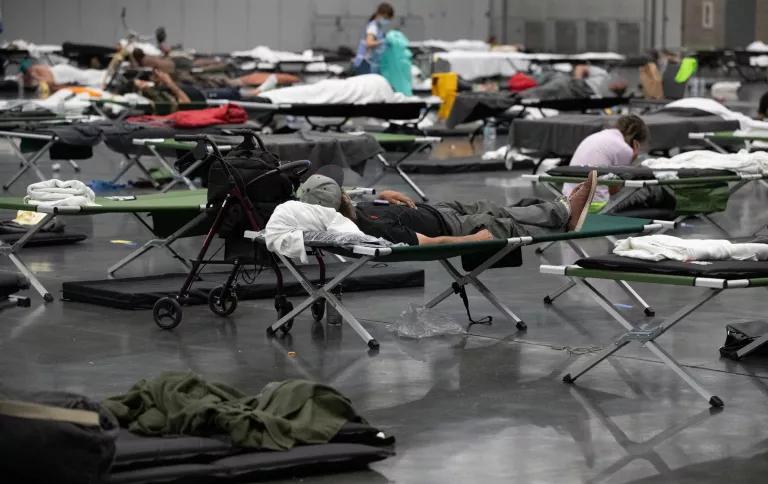
People resting on cots inside a cooling center set up at the Oregon Convention Center in Portland, Oregon, on June 27, 2021.
Finally, it is critical for local governments to have staff dedicated to heat preparedness and response. Heat touches everything humans depend on—our own bodies, our water supplies, our infrastructure, and more—but it tends to get far less attention than other types of extreme weather. Putting someone in charge who has the authority to work across departments and agencies can facilitate planning for the unique challenges that heat poses to residents and businesses.
Average temperatures are rising, and heat waves are getting longer, stronger, and more frequent. As the United States grapples with life in a much, much warmer climate, all levels of government must work to break down the barriers that prevent affordable and equitable access to indoor cooling. And, to ensure that air conditioning doesn’t warm the planet even further, the nation must move rapidly away from polluting fossil fuels and toward maximum energy efficiency. Indoor cooling isn’t a luxury anymore; it’s a life-saving technology that we know how to make cleaner and more affordable. It’s time to get to work.


